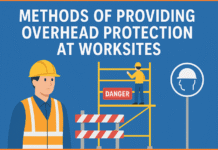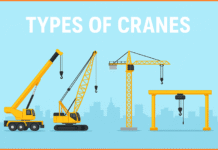Oil and Gas construction project site first aid incident and near-miss case study.
| Type of Incidents and Details | Root Causes | Suggestions/Recommendations |
| CASE STUDY 1. Near miss:– Unloading of flue gas duct from the trailer using 600T crane and 50T crane was under progress. For unloading, the duct was being shifted to a vertical position from the horizontal position. At this moment the load transferred onto two lifting lugs causing the weld joint failure resulting in the fall of the duct on the ground. | Welding joint strength of lifting lugs is not checked. | 1. Test certificate of Load-bearing capacity of the welding joints should be given by the manufacturer. 2. Physical verification of welding joints with an appropriate method. 3. Barrication of swing zone to prevent unauthorized entry. 4. Physical inspection of lifting tools and tackles before putting them to use. |
| CASE STUDY 2. First-Aid: The Injured person was involved in placing the flange of the pure gas pipeline on the ground. While placing, the injured person right hand finger caught in between flange and ground resulted in cut injury. | 1. Improper supervision. 2. Placing hands directly beneath the load. | 1. Mechanizing the task by using a chain pulley block. 2. Using rebar/pipes beneath the load instead of hands. 3. Vigilant supervision. 4. Discussing the job at a work location with the work crew. |
| CASE STUDY 3. Near Miss: A welder was doing welding work at height of 12m elevation. Welding cable joint got in contact with main power cable resulting cable short and power got tripped. This resulted in no injury. | 1. Welding cable joints-lugs causing heat. 2. Loosened nuts at welding lugs joints. | 1. Welding cables should not be joined. 2. If not possible using cable jointer instead of welding lugs with bolt and nut. 3. Regular maintenance of cables. 4. Power cables and welding cables shall be routed separately |
| CASE STUDY 4. Near Miss: A Stainless steel pipe(1-inch dia and L shape) was being shifted to the top of a technical structure at a height of 8m using PP rope. After reaching approx.5m from the ground, suddenly the rope got loosened and the pipe fell on the pipelines which are at height of 3m. This resulted in no injury. | 1. PP rope was not tightened properly with the pipe. 2. Improper method of securing the pipe. | 1. The pipe should be secured properly with PP rope. 2. The area should be barricaded to prevent unauthorized entry. 3. Position and angle of pull shall be free from obstructions. 4. Mechanizing the task rather than the manual. |
| CASE STUDY 5. Near Miss: welding work under progress on Technical Structure. Welder changed the job position by shifting welding the welding cable. At that instance, the welding cable joint(no insulation) got in contact with pipe support resulting in tripping of ELCB at Power Distribution Board of welding machines. This resulted in no injury. | Welding cables should not be joined. | 1. Welding cables should not be joined. 2. If not possible using cable jointer instead of welding lugs with bolt and nut. 3.Regular maintenance of cables. 4. Cable shall be routed overhead |
| CASE STUDY 6. Near Miss: Pipe fit up i.e., clit welding work in the main pipe-rack at a height of 12m was under progress. A clit (50gm, L-50*30mm approx.) slipped from his hand fell to the ground and resulted in no injury. | Loose material not secured. | 1. Securing of objects with binding wire/rope to arrest the fall. 2. Safety net shall be tied below the beam double layered(arresting men and material) 3. Barricading the bottom area to prevent unauthorized entry. 4. Adequate supervision shall be ensured. |
| CASE STUDY 7. Near Miss: A gang of 3 riggers was engaged in scaffolding at Main pipe rack. In order to give the clamps to the rigger, helper threw clamp at him for holding but the clamp hit the ledger pipe and clamp fell beside the helper. It resulted in no injury. | Improper method of giving materials to a higher elevation. | 1. Material shall be shifted using PP rope after collecting the required clamps, small objects in jute bag/gunny bag. 2. Awareness among helpers and riggers by training on safe procedure while the erection of scaffolding. 3. Communicating the risk of throwing objects. 4. Communication of job safety analysis to work team |
| CASE STUDY 8. INCIDENT: A job of pipe erection (Approx. 6m length and 12” diameter) using hydra crane connected to load with web sling at a height of 6m in Main pipe Rack. The pipe was rested on the incoming 440V power cable which was on the beam. In order to pull the pipe to the desired location workers used chain pulley block attached to web sling. As the pulling started the cable that was struck got crushed and punctured leading to short circuit (Armour and Y phase). That cable caught fire burned and Y phase fuse blown off and web sling also burned. Immediately electricians reached SUBSTATION and disconnected the power supply of incoming cable. It resulted in no injury. | 1. Pulling the pipe resulting in crushing the cable. 2. Damage of cable insulation – Armour and Y phase got contact. 3. Improper lifting. 4. No job planning at work area. 5. Poor Supervision. | 1. FRLS (Fire Retardant Low smoke) Cable shall be used. 2. Earth Leakage Protection shall be provided for all construction power supply feeders. 3. Vigilant supervision shall be ensured in the work area. 4. Barricade the work area to prevent unauthorized entry into the work zone. 5. The work-related briefing shall be done before executing the job. 6. If any power cable found in the work area, power shall be switched off if required. 7. Single Line diagram on the Power distribution board panel shall be made available which reduces the time duration to switch off the power supply in case of emergency. |
| CASE STUDY 8. NEAR MISS- Gas cutting work of clits on beam was under progress on the technical structure at a height of 60m. During the work, the clit that was cut fell down to zero meters beside the workmen of other agencies. | 1. Securing of loose objects. 2. Simultaneous works at different elevations. | 1. Clit shall be secured first and then cutting shall be done. 2. Simultaneous work is not allowed at different elevations under any circumstances. 3. Lack of coordination with other agencies. 4. Communication and discussion with the engineer rather than workers. 5. Conducting TBT on hazards of simultaneous work and the significance of securing loose objects. |






Please send me